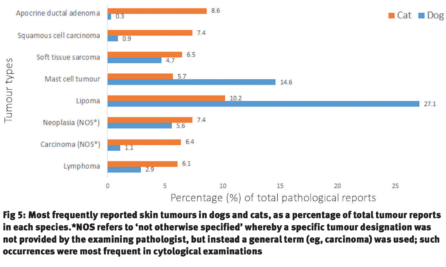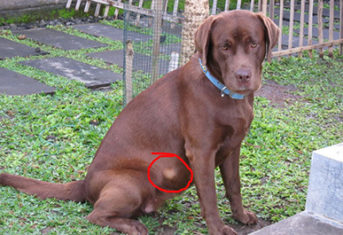Lumps and Bumps on Your Dog and Cat

Lumps and Bumps on Your Dog and Cat
November is National Pet Cancer Awareness Month. According to the National Cancer Institute, one in ten dogs will have a new diagnosis of cancer in any given year. The numbers for cancer in cats are similar. This blogpost will focus on the most common and easily recognizable cancer in pets, skin cancer.
Common Canine Skin Cancers
In the United Kingdom, over 200 veterinary practices have joined forces to compile data on diseases of dogs and cats. The group, SAVSNET (Small Animal Veterinary Surveillance Network) recently reported summary data from 100,000 tumors which have been added to a newly created tumor registry. The tumor samples were collected from three different pathology laboratories over a 14-month period in 2018-2019. Over 90% of the samples came from dogs. Of the samples from dogs, 72% were skin tumors, while in the cat samples, only 50% were skin tumors. This data confirms skin cancer is more common in dogs than in cats.
Benign, Fatty Tumors are the Most Common Tumors in Dogs and Cats
I think most dog families know that fatty tumors, or lipomas, are common in dogs. This data confirms the prevalence of these benign tumors. However, I was surprised to see that lipomas were also the most common skin tumor in cats, even though they are much less common in cats than in dogs. As an oncologist, lipomas are an annoyance. Lipomas can easily be mistaken for other more ominous skin tumors, such as mast cell tumors, soft tissue sarcomas or mammary gland tumors. Unfortunately, these tumors cannot be diagnosed by feel – whether they’re squishy or hard. Skin lumps should be tested by fine needle aspiration cytology to determine if the lump is a lipoma or not and to help guide the treatment plan for your dog.
Mast Cell Tumors
Mast cell tumors are the most common malignant tumor occurring in the skin of dogs. (In cats, it’s squamous cell carcinoma.) The new SAVSNET tumor registry gives some important information for owners of specific dog breeds. Labrador retrievers, Boxers, Staffordshire bull terriers and Chinese pugs are all at greater risk of mast cell tumors. Owners of these dogs should be especially vigilant regarding skin masses. Boxers were also noted to have more soft tissue sarcomas than average.
If you are interested in learning more about skin masses in dogs and cats, sign up for the Usdan Institute for Animal Health Education’s virtual event on December 9th at 6pm EST featuring AMC’s surgical oncologist, Dr. Katie Kennedy. Her talk, “Finding a Lump or Bump on Your Pet,” will highlight the reasons behind lumps and bumps on your pet. The cause of these lumps isn’t only skin deep! Learn what to be on the lookout for as well as the different treatment options your veterinarian may recommend for the lump on your pet.































